
Schmuck aus schwarzem Gold: Ein vollständiger Leitfaden
 Schwarzgold ist eine Goldart, die durch verschiedene Techniken künstlich geschwärzt wird. Wie Weißgold oder Roségold ist Schwarzgold eine weitere Option für Goldschmuckfarben außerhalb des traditionellen Gelbs.
Schwarzgold ist eine Goldart, die durch verschiedene Techniken künstlich geschwärzt wird. Wie Weißgold oder Roségold ist Schwarzgold eine weitere Option für Goldschmuckfarben außerhalb des traditionellen Gelbs.
Wenn Sie alles in Schwarz lieben, ist schwarzer Goldschmuck möglicherweise die perfekte Wahl für Sie. Dieser Goldton verleiht einen kantigen, unkonventionellen Stil, der zugleich raffiniert ist.
Ist Schwarzgold echtes Gold? Irgendwie schon. Natürliches Gold kommt nur in Gelb vor. Genau wie Weißgold oder Roségold kommt Schwarzgold nicht in der Natur vor; es muss verändert werden, um diese Farbe zu erhalten. Aber die geschwärzte Goldbasis ist echtes Gold.
Heute erzählen wir Ihnen alles über Schmuck aus Schwarzgold, wie er im Vergleich zu anderen schwarzen Metallen abschneidet, wie viel er kostet und wie Sie ihn pflegen.
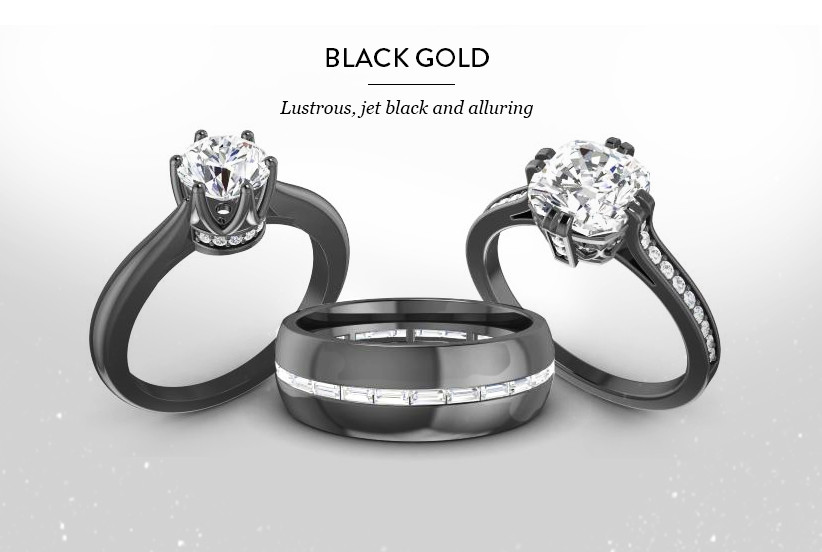
Was ist schwarzes Gold?
Obwohl „schwarzes Gold“ ein allgemeiner Begriff für Öl oder Erdöl ist, bezieht sich dieser Begriff auch auf farbiges Gold.
Gold kommt in der Natur nicht mit schwarzer Farbe vor. Tatsächlich muss jedes Gold außer Gelbgold verändert werden, um eine neue Farbe anzunehmen.
Roségold entsteht beispielsweise durch die Mischung von Gelbgold (der natürlichen Form) mit Kupfer, oft in einer Mischung aus 75 Prozent Gold und 25 Prozent Kupfer, um 18 Karat Roségold zu erhalten. Weißgold kann hingegen durch die Mischung von Gelbgold mit Metallen wie Nickel, Zink, Palladium oder einer Kombination davon hergestellt werden.
Wenn Sie Gold mit anderen Metallen mischen, entsteht eine Legierung. Die zusätzlichen Metalle, die Sie beimischen, und die Technik, mit der Sie die Metalle kombinieren, bestimmen die neue Farbe des Goldes.
Woraus besteht schwarzes Gold? Das hängt von der Technik ab, die wir als nächstes besprechen.

Wie wird schwarzes Gold hergestellt?
Was Legierungen angeht, können Juweliere dem Gold Kobalt, Rhodium, Ruthenium oder eine Kombination davon hinzufügen, um schwarzes Gold herzustellen.
Es gibt verschiedene Methoden, um schwarzes Gold herzustellen. Die beliebteste Methode ist die Galvanisierung, die wir zuerst behandeln.
Galvanisieren
Galvanisieren wird auch „elektrochemische Abscheidung“, „Elektroabscheidung“ oder einfach „Beschichten“ genannt. Obwohl diese Begriffe komplex klingen, ist diese Methode ziemlich unkompliziert.
Bei diesem Verfahren wird das Metall (in diesem Fall Gold) vorbereitet und anschließend in eine Lösung gegeben. Diese Lösung enthält ein neues Metall, das als Beschichtung auf dem Gold dient. Während sich das Gold in der Lösung befindet, lässt der Juwelier einen elektrischen Strom durch das Gold laufen, wodurch sich die Moleküle des neuen Metalls mit dem ursprünglichen Metall verbinden können.
Um schwarzes Gold herzustellen, muss die Lösung entweder schwarzes Rhodium , Nickel oder Ruthenium enthalten. Schwarzes Rhodium selbst entsteht durch die Beimischung verschiedener Legierungen wie Ruthenium, Zinnsulfat, Arsentrioxid oder Telluroxid zum Rhodium.
Das Ergebnis ist ein dunkelgraues, schwarzes oder schießenpulverfarbenes Metall – der genaue Farbton hängt von den dem Rhodium hinzugefügten Legierungen ab.
Der Hauptnachteil der galvanischen Beschichtung besteht darin, dass sie mit der Zeit verblasst. Sie können dies jederzeit beheben, indem Sie die Beschichtung erneuern lassen.
Malerei
Eine weniger verbreitete Methode, Gold zu schwärzen, besteht darin, eine schwarze Flüssigkeit auf die Goldoberfläche zu streichen. Sie können Acrylfarbe oder andere farbähnliche Flüssigkeiten (wie eine Mischung aus schwarzer Duco-Farbe und Duco-Verdünner) verwenden, um Gold auf diese Weise zu schwärzen. Sobald es trocken ist, sollten Sie die Farbe mit einem dünnen Lack, einer Politur oder einem Anlaufschutzspray versiegeln.
Diese Art von Schwarzgold kann leichter abplatzen und es kann schwierig sein, bei kunstvolleren Schmuckstücken eine gleichmäßige Farbe zu erzielen. Daher ist dies nicht die bevorzugte Technik für Schwarzgoldschmuck.
Emaille
Eine weitere Technik zur Herstellung von schwarzem Gold ist das Emaillieren. Beim Emaillieren wird Glaspulver bei sehr hoher Hitze (normalerweise zwischen 600 und 800 °C) mit Metall verschmolzen.
Sie können schwarzes Gold herstellen, indem Sie Emaille auf Gelbgold einbrennen. Das Endergebnis ist ein glattes, glänzendes und hartes Stück Schwarzgold.
Reines Gold ist wohl das beste Metall zum Emaillieren, da es nicht anläuft. Emaillieren ist eine der langlebigsten Methoden zur Herstellung von Schwarzgold – es läuft oft weniger schnell an als ein galvanisiertes Stück –, aber es ist auch eine der teuersten.
Oxidation
Schwarzes Gold kann auch durch Oxidation hergestellt werden. Bei dieser Technik wird eine Säure auf die Goldoberfläche aufgetragen, wodurch das Gold oxidiert und dunkler wird.
Da reines Gold nicht mit Sauerstoff reagiert, ist für die Oxidation Gold mit einer Karatzahl von weniger als 24 Karat erforderlich – also 22 Karat, 18 Karat , 14 Karat, 12 Karat oder 10 Karat Gold.
Durch Oxidation können die Metalle allerdings geschwächt werden, weshalb dies nicht ideal ist.
Laseranwendung
Die letzte Methode ist relativ neu: Femtosekundenlaserbehandlungen. Bei dieser Technik wird mit einem Laser ein hochenergetischer Impuls auf das Gold abgegeben, wodurch Mikrostrukturen entstehen, die Licht absorbieren. Das entstehende Stück sieht schwarz aus, weil es Licht absorbiert, anstatt es zu reflektieren.
Durch Laseranwendungen entsteht der haltbarste Schmuck aus Schwarzgold. Allerdings ist er derzeit noch recht teuer und daher nicht so verbreitet. Er könnte jedoch häufiger und erschwinglicher werden, wenn die Nachfrage steigt.
Wenn Sie sich einfach für Schmuck aus schwarzem Metall interessieren, möchten Sie vielleicht auch mehr über andere Optionen aus schwarzem Metall erfahren.
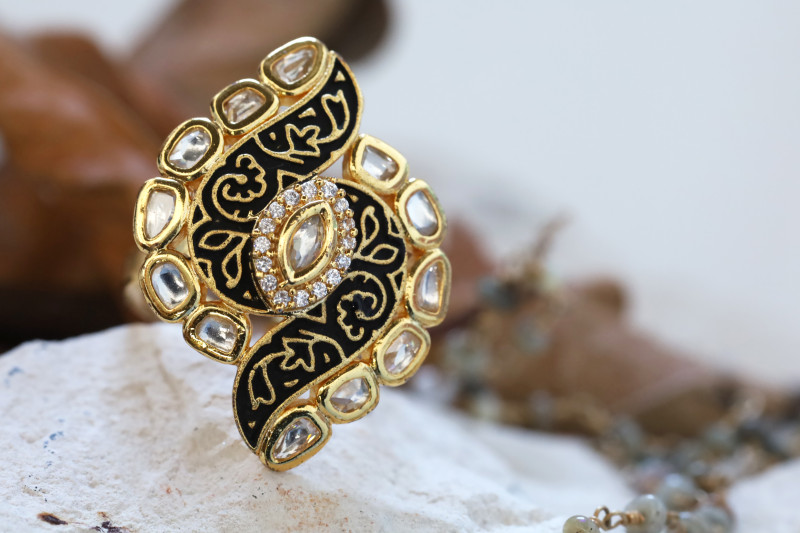
Schwarzes Gold im Vergleich zu anderen schwarzen Metallen
Schwarzes Gold ist nur eine Option für schwarzen Metallschmuck. Einige andere Optionen für schwarzen Schmuck sind:
Schwarze Keramik
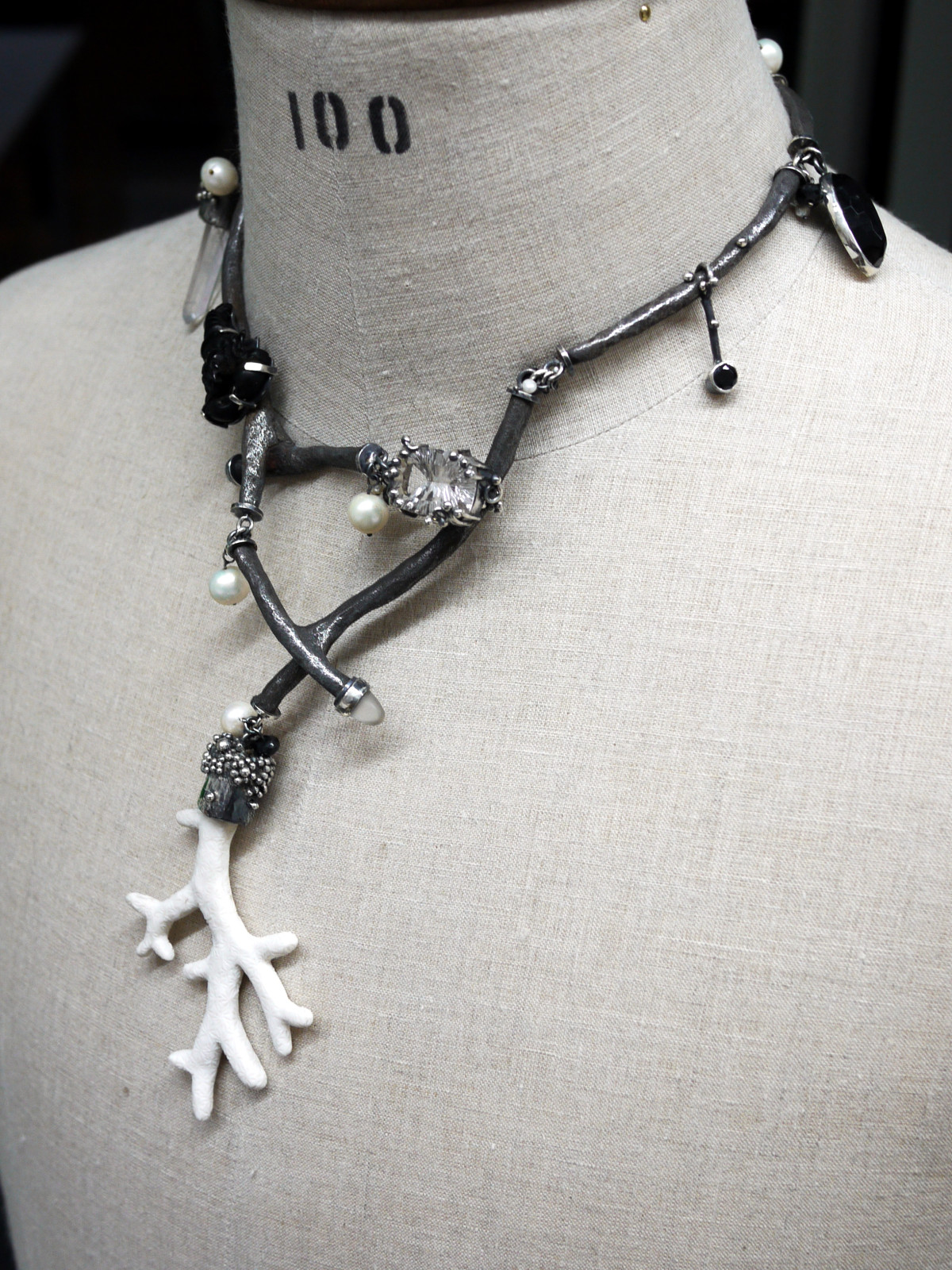 Bildnachweis: der gerechtfertigte Sünder | Flickr
Bildnachweis: der gerechtfertigte Sünder | Flickr
Schwarze Keramik ist ein Material, das ähnlich wie Metalle in Schmuckstücken verwendet wird. Es ist sehr hart und dennoch leicht und braucht keine Beschichtung, um schwarz zu sein. Das heißt, Kratzer enthüllen keine darunter verborgene andere Farbe.
Ein Vorteil von schwarzem Keramikschmuck ist, dass er glänzend und erschwinglich ist. Allerdings ist er zerbrechlicher und kann leicht zerbrechen, wenn er herunterfällt.
Schwarzes Wolfram

Eine weitere Option für schwarzes Metall ist Wolfram. Wie Gold muss Wolfram behandelt werden, um schwarz zu werden. Bei diesem Verfahren wird das Wolfram mit kleinen schwarzen Titan-Zirkonium-Legierungspartikeln bei sehr hoher Geschwindigkeit beschossen, damit die Partikel am Metall haften bleiben.
Zu den Vorteilen von schwarzem Wolfram gehören, dass es sehr kratzfest, hypoallergen und anlaufbeständig ist. Wolframschmuck kann jedoch wie Keramikschmuck zerspringen und seine Haltbarkeit macht es schwierig, die Größe zu ändern.
Schwarzes Titan
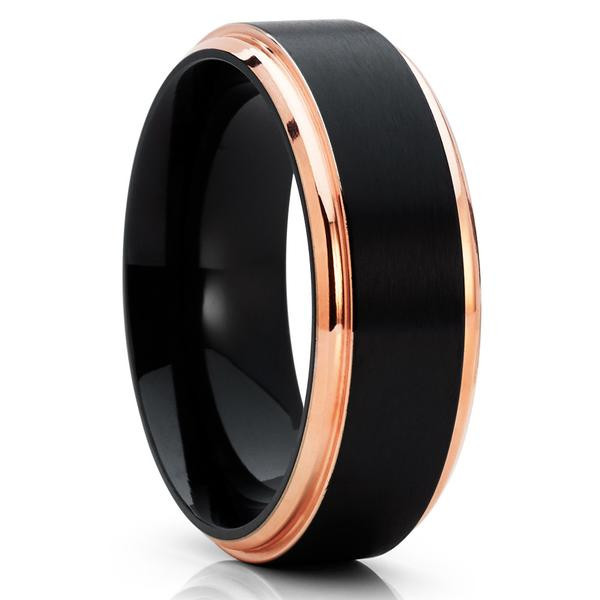
Titan ist die beliebteste Wahl für Schmuck aus schwarzem Metall.
Wie Gold kommt Titan in der Natur nicht in Schwarz vor. Schwarzes Titan entsteht durch die Beschichtung von Titan mit diamantähnlichem Kohlenstoff (DLC). Dadurch entsteht eine glänzende, kratzfeste, schwarze Oberflächenschicht. Durch die Verwendung von Kohlenstoff wird das fertige Metall sehr hitzebeständig und fühlt sich sehr glatt an.
Im Vergleich zu anderen dunklen Metallen wie Schwarzgold oder Silber ist schwarzes Titan oft haltbarer und preisgünstiger. Schwarzes Titan ist außerdem hypoallergen, korrosionsbeständig und chemisch inert (d. h. es reagiert nicht auf Chemikalien). Die Farbe sollte nicht verblassen oder anlaufen, es sei denn, es wird extremen Bedingungen ausgesetzt.
Der einzige Nachteil von Titan besteht darin, dass die Größenanpassung aufgrund der Haltbarkeit des Metalls – genau wie bei Wolfram – schwierig ist.
Kohlefaser

Kohlenstofffaser oder Graphitfaser ist ein Polymer, das ähnlich wie andere Metalle in Schmuck verwendet wird. Das Material ist superstark – tatsächlich 5-mal stärker als Stahl! Gleichzeitig ist es aber auch leicht – 3-mal leichter als Titan und 12-mal leichter als Gold.
Zu den Vorteilen von Schmuck aus Kohlefaser gehören sein geringes Gewicht, seine Langlebigkeit, Kratzfestigkeit, Hypoallergenität und Konfliktfreiheit. Außerdem ist dieser stilvolle schwarze Schmuck erschwinglich.
Der einzige Nachteil von Schmuck aus Kohlefaser besteht darin, dass er aufgrund seiner Leitfähigkeit nicht sicher zu tragen ist, wenn Sie mit Elektrizität arbeiten.
Schwarzer Edelstahl
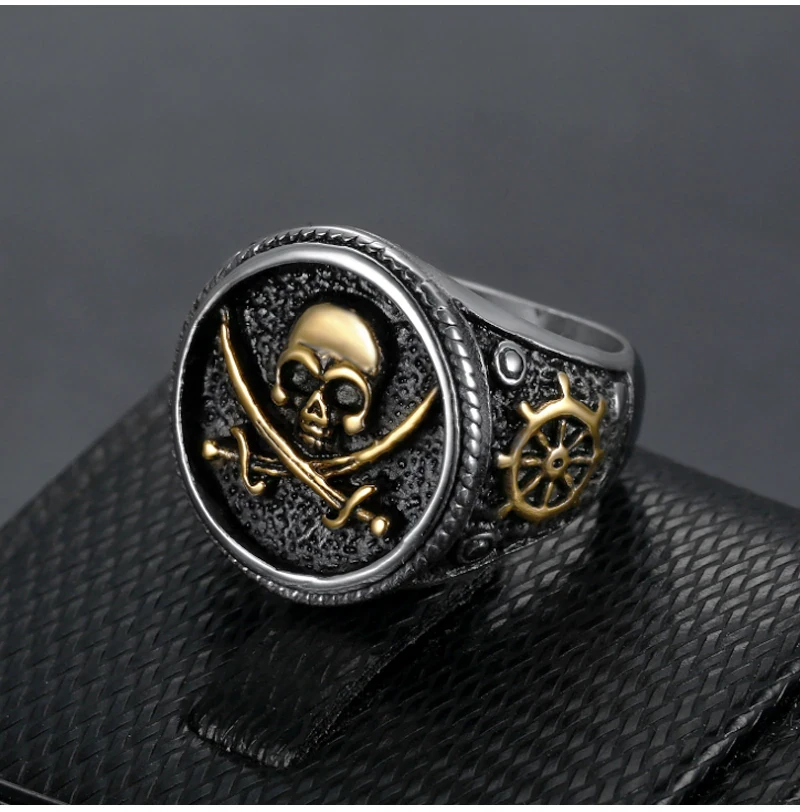
Edelstahl ist nicht nur für Kühlschränke geeignet – Sie können auch schwarzen Edelstahlschmuck finden! Es gibt zwei Möglichkeiten, schwarzen Edelstahl herzustellen: Acrylbeschichtung und Eloxieren.
Bei der Acrylbeschichtung wird Edelstahl mit schwarzem Acryl beschichtet. Diese Beschichtung lässt sich jedoch leicht abkratzen und ist daher für Schmuck nicht besonders gut geeignet.
Die meisten Schmuckstücke aus schwarzem Edelstahl sind eloxiert. Eloxieren ähnelt der Galvanisierung, aber anstatt ein anderes Metall auf das vorhandene Metall aufzutragen, wird die natürliche Oxidschicht des vorhandenen Metalls aufgebaut, wodurch eine dickere Oxidoberflächenschicht entsteht.
In diesem Fall ist die Oxidschicht des Edelstahls schwarz. Von dort aus erhitzt der Juwelier den Edelstahl, bis er den idealen schwarzen Farbton und Glanz aufweist.
Technisch gesehen kann Edelstahl nicht eloxiert werden, aber geschwärzter Edelstahl, der durch das oben beschriebene Verfahren hergestellt wird, wird dennoch als „eloxiert“ bezeichnet.
Einige Vorteile von eloxiertem Edelstahl sind, dass er korrosionsbeständig und für den täglichen Gebrauch geeignet ist. Um seine Haltbarkeit zu gewährleisten, sollten Sie jedoch eine Schutzbeschichtung auftragen.
Zirkonium
Zirkonium ist das einzige Schmuckmetall, das ohne komplexe Prozesse dauerhaft schwarz werden kann. Sie brauchen keine Beschichtungen; durch einfaches Erhitzen wird Zirkonium schwarz, da sich durch die Hitze eine Schicht aus Zirkoniumoxid bildet.
Einige Vorteile von Zirkonium sind, dass es hypoallergen, korrosionsbeständig, sehr kratzfest, leicht und langlebig ist. Obwohl Wolfram härter als Zirkonium ist, ist Zirkonium weniger spröde als Wolfram.
Damaszener Stahl
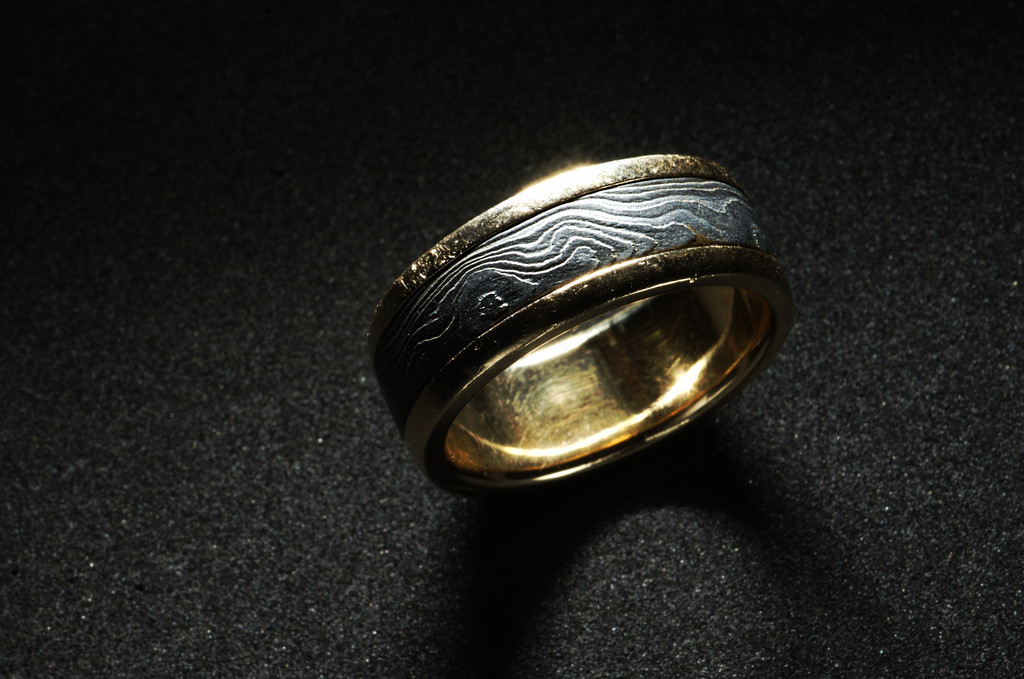
Sie haben wahrscheinlich schon von Waffen aus Damaszenerstahl gehört, aber dieses Metall kann auch für Schmuck verwendet werden! Damaszenerstahl entsteht durch das Verschweißen von Stahl- und Eisenschichten zwischen Hitze- und Schmiedevorgängen. Das Ergebnis ist ein silbernes, graues oder schwarzes Metall mit einem Wellenmuster, das oft zwischen helleren und dunkleren Tönen wechselt.
Damaszenerstahl hat nicht nur ein einzigartiges Aussehen, sondern ist auch äußerst kratz-, korrosions- und verschleißfest. Das Metall ist hart und flexibel und eignet sich daher hervorragend für kunstvolle Schmuckstücke.
Der einzige Nachteil von Damaszenerstahl besteht darin, dass es sich nicht um ein reines Schwarzmetall handelt, da er gemustert ist und oft ins Silberne tendiert.
Im Vergleich zu allen oben aufgeführten schwarzen Metallen ist schwarzes Gold einfach wertvoller, obwohl sein Wert von einigen Faktoren abhängen kann.

Der Wert des schwarzen Goldes
Erstens: Ist schwarzes Gold teurer als Gold? Technisch gesehen nicht, aber es kommt darauf an. Der Wert von schwarzem Gold hängt von der Reinheit (auch Karatzahl genannt) des darunter liegenden Goldes ab.
Gibt es 14-karätiges Schwarzgold? Ja, Sie können Schwarzgold in jeder Karatstärke außer 24 Karat finden, da 24-karätiges Gold zu 100 Prozent aus Gold besteht und farbiges Gold von Natur aus unrein ist. Für das beste Preis-Leistungs-Verhältnis empfehlen wir 14-karätiges Gold oder höher.
Was die Karatzahl betrifft, hängen die Preise für Schwarzgold hauptsächlich von der Karatzahl des Goldes ab. Das bedeutet, dass 18-karätiges Schwarzgold wertvoller ist als 14-karätiges Schwarzgold. Auch der Prozess, mit dem das Gold schwarz gemacht wird, kann eine Rolle spielen – galvanisiertes Schwarzgold ist wertvoller als oxidiertes oder lackiertes Schwarzgold, während emailliertes oder mit Laser aufgetragenes Schwarzgold wertvoller sein kann als galvanisiertes Schwarzgold.
Sie haben Goldschmuck, den Sie in Schwarzgoldschmuck verwandeln möchten? Die Preise für rhodinierten Schwarzgoldschmuck liegen normalerweise zwischen 75 und 120 US-Dollar.
Wenn Sie Schmuck aus Schwarzgold kaufen, müssen Sie damit rechnen, für zusätzliche Edelsteine oder andere Verzierungen einen Aufpreis zu zahlen.
Je nach Karatzahl kann Schwarzgoldschmuck eine Investition sein. Wie lange hält also eine Schwarzgoldbeschichtung? Und wie verhindert man, dass sie anläuft?
Die Pflege des schwarzen Goldes
Eine Schwarzgoldbeschichtung hält normalerweise 6 Monate bis 2 Jahre, abhängig von der Qualität der Beschichtung und davon, wie oft Sie den Gegenstand tragen.
Läuft Schwarzgold an? Schwarzgold ist kein reines Gold und kann daher mit der Zeit durch Kontakt mit Feuchtigkeit, Luft, Ölen und anderen Substanzen anlaufen. Sie können das Anlaufen von Schwarzgold verhindern, indem Sie es trocken halten, in einem luftdichten Behälter aufbewahren und ein Schmuckschutzspray verwenden.
Verblasst Schwarzgold? Galvanisiertes Schwarzgold nutzt sich mit der Zeit ab, ein Verblassen ist also unvermeidlich. Wenn Sie sehen, dass das Gelbgold durchscheint, lassen Sie es am besten neu galvanisieren, um die schwarze Farbe und den glänzenden Glanz wiederherzustellen.
Außer dass Sie Kratzer und Stöße vermeiden, können Sie durch regelmäßiges Reinigen auch die Lebensdauer Ihres Schwarzgoldschmucks verlängern.
Wie reinigt man schwarzes Gold?
Im Allgemeinen ist es am besten, Goldschmuck einmal pro Woche vorsichtig zu reinigen. Hier sind die Schritte zur sicheren Reinigung von Schwarzgoldschmuck:
Füllen Sie eine Schüssel mit warmem Wasser und mischen Sie eine milde Seife (z. B. Dawn-Spülmittel) hinein.
Tauchen Sie eine weiche Bürste (z. B. eine Zahnbürste) oder ein Tuch in das Seifenwasser und wischen Sie den Schwarzgoldschmuck dann vorsichtig ab.
Spülen Sie eventuelle Seifenreste ab.
Trocknen Sie das Schmuckstück aus Schwarzgold gründlich mit einem weichen Mikrofasertuch.
Hier sind noch einige Tipps, damit Ihr Schwarzgoldschmuck möglichst lange hält:
Tragen Sie keinen anderen Ring neben Ihrem Schwarzgoldring, da dies zu Kratzern führen könnte.
Legen Sie schwarzen Goldschmuck vor dem Schwimmen, anstrengenden Tätigkeiten, die zum Schwitzen führen können, oder vor der Hausarbeit wie dem Abwaschen ab.
Tragen Sie Parfüm, Lotionen oder andere Schönheitsprodukte auf (und lassen Sie sie trocknen), bevor Sie Ihren Schwarzgoldschmuck anlegen.
Halten Sie galvanisierten Schwarzgoldschmuck von Chlor und Säuren fern, da diese die Beschichtung beschädigen könnten.
Befolgen Sie diese Schritte und Ihr Schwarzgoldschmuck wird jahrelang glänzen!
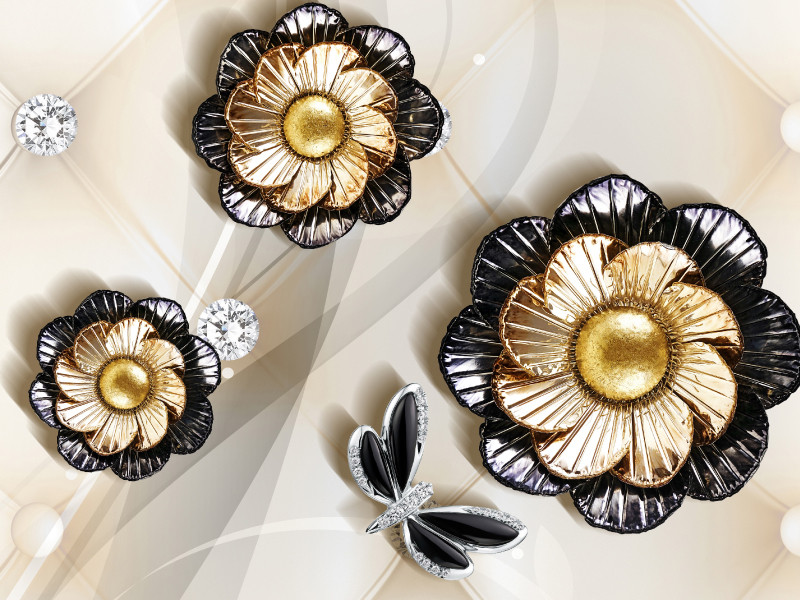
Möchten Sie Ihren Schmuck schwarz lackieren?
Wenn Sie Gelbgold sehen und es schwarz streichen möchten, ist Schwarzgoldschmuck die richtige Wahl für Sie. Der einzigartige, kantige Look des Metalls bietet eine unkonventionelle und dennoch raffinierte Ästhetik, die perfekt zu praktisch jedem Look passt.
Bereit zum Einkaufen? Stöbern Sie durch unsere Kollektion an Schwarzgoldschmuck!
Suche nach Fashion Encyclopedia
Verwandte Auktionen
In Verbindung stehende Artikel
Was verursacht Hautausschläge und allergische Reaktionen bei Goldschmuck? Nun, der Hautausschlag, den Sie erleben, wird wahrscheinlich nicht von Gold herrühren, da Goldallergien äußerst selten sind.
22nd Sep 2019
Sie sind hin- und hergerissen zwischen Weißgold und Gelbgold? Der Grund dafür ist leicht zu erkennen! In diesem Artikel vergleichen wir die beiden Metalle, um herauszufinden, welches das Richtige für Sie ist!
11th Mar 2020
Neue Artikel
Titan ist ein beliebtes Schmuckmetall, das für sein geringes Gewicht, seine Langlebigkeit und seinen günstigen Preis bekannt ist. Erfahren Sie alles über Titan, wie es im Vergleich zu ähnlichen Metallen abschneidet und welche Vor- und Nachteile Titanschmuck hat.
7th Feb 2023
Erfahren Sie alles über Wolframschmuck – von seiner Geschichte und Verwendung bis hin zu seiner Haltbarkeit und Pflege. Am Ende unseres Leitfadens wissen Sie, ob Wolfram das Richtige für Sie ist!
7th Feb 2023
Sie möchten Ihre Sammlung edler Accessoires um zeitlosen Weißgoldschmuck ergänzen? Hier erfahren Sie alles Wissenswerte über edles Weißgold!
29th Jan 2023




